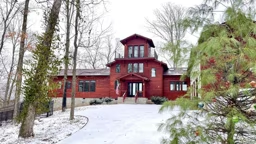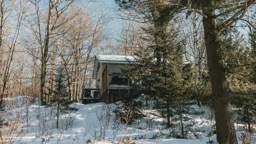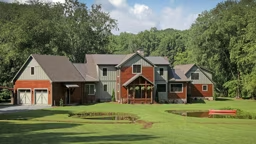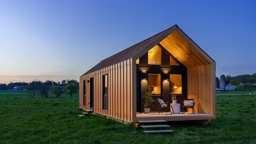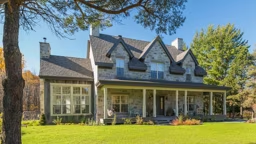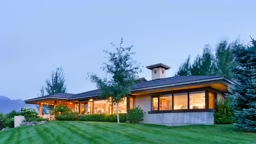What to do when unannounced guests drop by for dinner? No worries, mate, when your cabin is a Queenslander. Simply toss more shrimp on the barbie and kick back on the veranda.
But you don’t have to live Down Under to roost in a tropical beach house. This beauty happens to be on the southeast shore of Lake Michigan.
And you don’t have to be an Aussie, either – although it helps.
Just ask Bill Gunnar. Gunnar’s ancestors lived in Australia in the late 1800s. In fact, his great-grandfather and namesake, Sir William McMillan, was a member of Parliament in 1901 when Australia became a unified commonwealth.
During that time, a new housing style was taking hold in the state of Queensland on Australia’s
northeast coast. Built on stilts or tall stumps, the “Queenslander” offered respite from the heat, humidity and insects of the subtropics. High enough to walk under, the structure allowed for cooling breezes and easy termite inspection. A wraparound veranda encouraged outdoor living.
Fast forward a century to Sawyer, Mich., where architect Howard Holtzman, AIA, is sketching designs on the beach. Gunnar has asked him to design a vacation home that will offer open, recreational living atop a 70-foot-high sand dune.
But you don’t have to live Down Under to roost in a tropical beach house. This beauty happens to be on the southeast shore of Lake Michigan.
And you don’t have to be an Aussie, either – although it helps.
Just ask Bill Gunnar. Gunnar’s ancestors lived in Australia in the late 1800s. In fact, his great-grandfather and namesake, Sir William McMillan, was a member of Parliament in 1901 when Australia became a unified commonwealth.
During that time, a new housing style was taking hold in the state of Queensland on Australia’s
northeast coast. Built on stilts or tall stumps, the “Queenslander” offered respite from the heat, humidity and insects of the subtropics. High enough to walk under, the structure allowed for cooling breezes and easy termite inspection. A wraparound veranda encouraged outdoor living.
Fast forward a century to Sawyer, Mich., where architect Howard Holtzman, AIA, is sketching designs on the beach. Gunnar has asked him to design a vacation home that will offer open, recreational living atop a 70-foot-high sand dune.
INSULATION
Insulation keeps heat out of the cabin.
In the Queenslander cabin, structural insulating panels (SIPS) were used for walls, ceilings and floors. These prefabricated panels, which consist of rigid foam sandwiched between two sheets of oriented strand board, created a tight, energy-efficient envelope around the home.
Even more effective is the newer spray foam insulation (trade name: Corbond). When sprayed between wall studs or joints, it immediately expands and seals air gaps. “It’s closed cell, so it doesn’t have a dew point. Moisture doesn’t get in or out,” explains Holtzman. “Corbond costs more than glass fiber batting, but it’s used all over the West in places like Aspen where there are restrictive energy requirements.”
Radiant barriers installed below the roof block heat entry into the cabin. Typically, a barrier consists of a reflective material like aluminum foil backed by oriented strand board.
Insulation keeps heat out of the cabin.
In the Queenslander cabin, structural insulating panels (SIPS) were used for walls, ceilings and floors. These prefabricated panels, which consist of rigid foam sandwiched between two sheets of oriented strand board, created a tight, energy-efficient envelope around the home.
Even more effective is the newer spray foam insulation (trade name: Corbond). When sprayed between wall studs or joints, it immediately expands and seals air gaps. “It’s closed cell, so it doesn’t have a dew point. Moisture doesn’t get in or out,” explains Holtzman. “Corbond costs more than glass fiber batting, but it’s used all over the West in places like Aspen where there are restrictive energy requirements.”
Radiant barriers installed below the roof block heat entry into the cabin. Typically, a barrier consists of a reflective material like aluminum foil backed by oriented strand board.
Preserving the Dune
Deposited by retreating glaciers that once covered Michigan, the big lake’s dunes are the largest assemblage of freshwater dunes in the world. They support a wide diversity of habitats, from forests of oak, hemlock and pine to open dunes to interdunal ponds.
The dune on the property Gunnar had bought was stable and wooded. All parties involved wanted to leave the site as intact as possible.
The challenge was to build a house with generous outdoor living areas without doing any grading or disturbing the trees. The solution: a long, narrow home that mimics the line of the sand dune, surrounded by a covered veranda.
When the numerous French doors are thrown open, the interior spills out onto the screened portions for total indoor-outdoor living. There are 2,000 square feet of “outdoor” living space, half of them enclosed.
“In summer, the house works great for a number of people because it can expand,” says Gunnar.
Deposited by retreating glaciers that once covered Michigan, the big lake’s dunes are the largest assemblage of freshwater dunes in the world. They support a wide diversity of habitats, from forests of oak, hemlock and pine to open dunes to interdunal ponds.
The dune on the property Gunnar had bought was stable and wooded. All parties involved wanted to leave the site as intact as possible.
The challenge was to build a house with generous outdoor living areas without doing any grading or disturbing the trees. The solution: a long, narrow home that mimics the line of the sand dune, surrounded by a covered veranda.
When the numerous French doors are thrown open, the interior spills out onto the screened portions for total indoor-outdoor living. There are 2,000 square feet of “outdoor” living space, half of them enclosed.
“In summer, the house works great for a number of people because it can expand,” says Gunnar.
A Northern Queenslander is Born
When Gunnar first contacted Holtzman about designing his beachside vacation home, the architect happened to be in Queensland designing an ocean-class yacht. “I liked the homes-on-posts,” Holtzman recalls, and those homes were his inspiration. Of course, the Queenslander style hit home with Gunnar.
Found today all over Australia, the quintessential Queenslander is timber-frame clad with wood. “It’s fairly lightweight with no wall cavity,” notes Holtzman. The Michigan house is more substantial because it needed insulation for its colder climate.
The 2,600-square-foot cabin utilizes post and beam construction by Riverbend Timber Framing of Blissfield, Mich., and structural insulated panels from Insulspan, Riverbend’s sister company.
Riverbend Timber Framing does the pre-construction work offsite, says Gunnar. “A big flatbed truck showed up in front. They built it like an erector set – prefabricated insulated panels, roof and ceiling,” he marvels. “Within a week, I had a home.”
Builder Gray Carlson of Carlson Construction in Michiana Shores, Ind., lent his expertise on preserving the natural contour and vegetation of the dunes in this resort area.
“Because we didn’t want to disturb the trees, we had a very narrow spot to build on,” says Carlson. That also meant that there was no place to store building materials on site. So Carlson’s crew had to haul the materials away at night, then haul it all back the next day. The off-site pre-assembly construction method was ideal for this lot that had a limited footprint and was hard to access.
When Gunnar first contacted Holtzman about designing his beachside vacation home, the architect happened to be in Queensland designing an ocean-class yacht. “I liked the homes-on-posts,” Holtzman recalls, and those homes were his inspiration. Of course, the Queenslander style hit home with Gunnar.
Found today all over Australia, the quintessential Queenslander is timber-frame clad with wood. “It’s fairly lightweight with no wall cavity,” notes Holtzman. The Michigan house is more substantial because it needed insulation for its colder climate.
The 2,600-square-foot cabin utilizes post and beam construction by Riverbend Timber Framing of Blissfield, Mich., and structural insulated panels from Insulspan, Riverbend’s sister company.
Riverbend Timber Framing does the pre-construction work offsite, says Gunnar. “A big flatbed truck showed up in front. They built it like an erector set – prefabricated insulated panels, roof and ceiling,” he marvels. “Within a week, I had a home.”
Builder Gray Carlson of Carlson Construction in Michiana Shores, Ind., lent his expertise on preserving the natural contour and vegetation of the dunes in this resort area.
“Because we didn’t want to disturb the trees, we had a very narrow spot to build on,” says Carlson. That also meant that there was no place to store building materials on site. So Carlson’s crew had to haul the materials away at night, then haul it all back the next day. The off-site pre-assembly construction method was ideal for this lot that had a limited footprint and was hard to access.
It's All in the Details
The long, narrow cabin is approximately 30 feet by 100 feet, and its length is oriented along a north-south axis. The front elevation faces west toward Lake Michigan. To the east lies a wooded ravine.
Gunnar departed from the traditional Queenslander metal roof in favor of cedar shakes. But the front door boasts a fan-shaped design – a common Queenslander touch.
Inside, steel joiners feature whimsical cut-out stars to make these structural components decorative. All interior posts and trusses are oak.
A central great room comprises one-third of the main floor. At one end is a master bedroom suite with storage loft and bath. On the opposite end of the great room are two bedrooms and a three-bunk sleeping loft.
A bumped-out galley kitchen has two side doors that open onto the veranda. The kitchen’s raised bar accommodates casual eating while screening cooking clutter from the great room.
Though the design is ideal for waterside locales, it would work equally well for any exposed site that has great vistas, notes Gunnar. “Particularly when a good portion of the year you have the opportunity to live outdoors. In the summer, it’s wonderful to have the transoms and French doors open.”
And in the winter, two fireplaces – one in the master bedroom and one in the great room with a Wisconsin limestone surround – keep the cabin toasty. The Queenslander’s elevation above ground makes installation and maintenance of electrical and plumbing systems a breeze. It also provides space to store boats and vehicles.
Frances Sigurdsson has gone walkabout in the Albany Pine Bush –?New York’s inland glacial sand dune landscape.
The long, narrow cabin is approximately 30 feet by 100 feet, and its length is oriented along a north-south axis. The front elevation faces west toward Lake Michigan. To the east lies a wooded ravine.
Gunnar departed from the traditional Queenslander metal roof in favor of cedar shakes. But the front door boasts a fan-shaped design – a common Queenslander touch.
Inside, steel joiners feature whimsical cut-out stars to make these structural components decorative. All interior posts and trusses are oak.
A central great room comprises one-third of the main floor. At one end is a master bedroom suite with storage loft and bath. On the opposite end of the great room are two bedrooms and a three-bunk sleeping loft.
A bumped-out galley kitchen has two side doors that open onto the veranda. The kitchen’s raised bar accommodates casual eating while screening cooking clutter from the great room.
Though the design is ideal for waterside locales, it would work equally well for any exposed site that has great vistas, notes Gunnar. “Particularly when a good portion of the year you have the opportunity to live outdoors. In the summer, it’s wonderful to have the transoms and French doors open.”
And in the winter, two fireplaces – one in the master bedroom and one in the great room with a Wisconsin limestone surround – keep the cabin toasty. The Queenslander’s elevation above ground makes installation and maintenance of electrical and plumbing systems a breeze. It also provides space to store boats and vehicles.
Frances Sigurdsson has gone walkabout in the Albany Pine Bush –?New York’s inland glacial sand dune landscape.
HOT ADVICE
Cool cabins can be your base for year-round fun in the sun. But if you’re building in a hot climate, watch out! The desert sun can be blistering. And bugs, rain, and humidity in the Deep South will conspire to drive you inside.
Make sure your hot-weather retreat will shelter you from the elements while also encouraging outdoor living. Consider “green,” ecological approach instead of trying to control the environment with mechanicals – especially if your site is in a remote area.
Keep these factors in mind for natural heatingand cooling:
• Site orientation. Note the path the sun follows through the day, and the directions of prevailing winds. East and west exposure in the desert is hotter than in the northern part of the country, notes architect Howard Holtzman, who designed the Queenslander cabin featured here. “In the dry desert, the best thing you can have is shade. It can be 104 degrees, but if you’re under a tree you’ll be fine.”
• Incorporate the least amount of surface – a symmetrical, rectangular shape, for example – to minimize heat gain.
• Large overhangs and wide, covered porches keep sun off walls. So do awnings, exterior shutters, and deciduous vines on trellises.
• Crawl spaces beneath the house provide ventilation.
• In a hot, humid climate, place windows to take advantage of cross breezes. (Opt for casement or louvered windows that can be fully opened.)
• Avoid windows on west-facing walls in hot, arid zones.
• Use low-e windows designed for hot climates with a solar heat gain coefficient of .40 or less. Consider skylights with translucent glazing to diffuse light. Keep direct sun off all windows.
• Warm air rises. So if it’s hot and dry out, high ceilings will induce thermal ventilation. Clerestory windows high up on the walls and skylights that open bring in light and vent hot air. Energy Star ceiling fans reduce the need for air conditioning.
• Thermal mass – the ability of a material to absorb and retain heat – is an ally in the desert where it’s hot by day and cool at night. Stone or concrete walls or flooring absorb heat during the day and radiate it at night. So does ceramic floor tile.
• A white tile or metal roof will reflect heat and reduce the need for air-conditioning in a hot climate that doesn’t cool off much at night.
Source: Good Green Homes by Jennifer Roberts, Gibbs Smith, 2003.
Cool cabins can be your base for year-round fun in the sun. But if you’re building in a hot climate, watch out! The desert sun can be blistering. And bugs, rain, and humidity in the Deep South will conspire to drive you inside.
Make sure your hot-weather retreat will shelter you from the elements while also encouraging outdoor living. Consider “green,” ecological approach instead of trying to control the environment with mechanicals – especially if your site is in a remote area.
Keep these factors in mind for natural heatingand cooling:
• Site orientation. Note the path the sun follows through the day, and the directions of prevailing winds. East and west exposure in the desert is hotter than in the northern part of the country, notes architect Howard Holtzman, who designed the Queenslander cabin featured here. “In the dry desert, the best thing you can have is shade. It can be 104 degrees, but if you’re under a tree you’ll be fine.”
• Incorporate the least amount of surface – a symmetrical, rectangular shape, for example – to minimize heat gain.
• Large overhangs and wide, covered porches keep sun off walls. So do awnings, exterior shutters, and deciduous vines on trellises.
• Crawl spaces beneath the house provide ventilation.
• In a hot, humid climate, place windows to take advantage of cross breezes. (Opt for casement or louvered windows that can be fully opened.)
• Avoid windows on west-facing walls in hot, arid zones.
• Use low-e windows designed for hot climates with a solar heat gain coefficient of .40 or less. Consider skylights with translucent glazing to diffuse light. Keep direct sun off all windows.
• Warm air rises. So if it’s hot and dry out, high ceilings will induce thermal ventilation. Clerestory windows high up on the walls and skylights that open bring in light and vent hot air. Energy Star ceiling fans reduce the need for air conditioning.
• Thermal mass – the ability of a material to absorb and retain heat – is an ally in the desert where it’s hot by day and cool at night. Stone or concrete walls or flooring absorb heat during the day and radiate it at night. So does ceramic floor tile.
• A white tile or metal roof will reflect heat and reduce the need for air-conditioning in a hot climate that doesn’t cool off much at night.
Source: Good Green Homes by Jennifer Roberts, Gibbs Smith, 2003.







